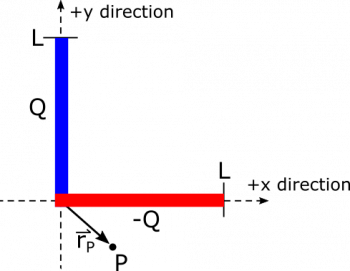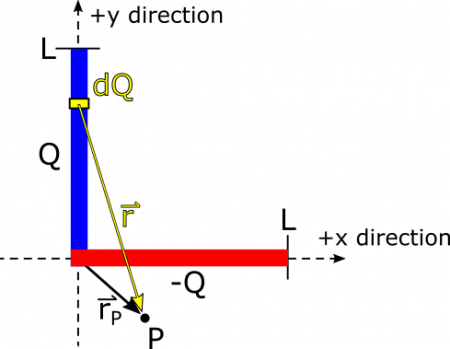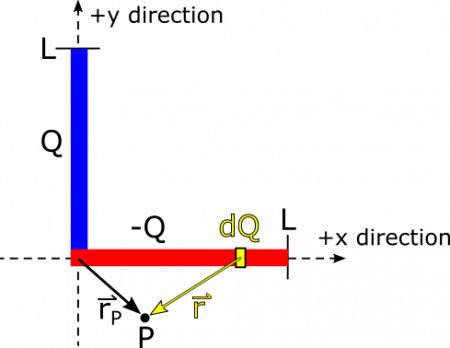This is an old revision of the document!
Example: Two Segments of Charge
Suppose we have two segments of uniformly distributed charge, one with total charge $+Q$, the other with $-Q$. The two segments each have length $L$, and lie crossed at their endpoints in the $xy$-plane. The segment with charge $+Q$ lies along the $y$-axis, and the segment with charge $-Q$ lies along the $x$-axis. See below for a diagram of the situation. Create an expression for the electric field $\vec{E}_P$ at a point $P$ that is located at $\vec{r}_P=r_x\hat{x}+r_y\hat{y}$. You don't have to evaluate integrals in the expression.
Facts
- One segment lies on the $y$-axis stretching from $0$ to $L$, with charge $Q$ uniformly distributed.
- The other segment lies on the $x$-axis stretching from $0$ to $L$, with charge $-Q$ uniformly distributed.
- The point $P$ is at the arbitrary location $\vec{r}_P=r_x\hat{x}+r_y\hat{y}$
- The electric field due to a point charge is $$\vec{E} = \frac{1}{4\pi\epsilon_0}\frac{q}{r^3}\vec{r}$$
- The electric field at $P$ is the superposition of contributions from the two segments: $$\vec{E}_P = \vec{E}_{+Q} +\vec{E}_{-Q}$$
Goal
- Find $\vec{E}_P$.
Representations
Solution
Approximation
We begin with an approximation, which will make our calculations simpler, and makes sense based on our representation:
- The thicknesses of both segments are infinitesimally small, and we can approximate them as line segments.
This example is complicated enough that it's worthwhile to make a plan.
Plan
We will use integration to find the electric field from each segment, and then add the electric fields together using superposition. We'll go through the following steps.
- For the first segment, find the linear charge density, $\lambda$.
- Use $\lambda$ to write an expression for $\text{d}Q$.
- Assign a variable location to the $\text{d}Q$ piece, and then use that location to find the separation vector, $\vec{r}$.
- Write an expression for $\text{d}\vec{E}$.
- Figure out the bounds of the integral, and integrate to find electric field at $P$.
- Repeat the above steps for the other segment of charge.
- Add the two fields together to find the total electric field at $P$.
Because we know that electric fields add through superposition, we can treat each of the charges separately, find the electric field, then add the fields together at $P$ at the end. We can begin with the electric field due to the segment along the $y$-axis. We start by finding $\text{d}Q$ and $\vec{r}$. The charge is uniformly distributed so we have a simple line charge density of $\lambda=Q/L$. The segment extends in the $y$-direction, so we have $\text{d}l=\text{d}y$. This gives us $\text{d}Q$: $$\text{d}Q=\lambda\text{d}l=\frac{Q\text{d}y}{L}$$
Assumption
The charge is evenly distributed along each segment of charge. This allows each little piece of charge to have the same value for charge density along each line.
The separation vector $\vec{r}$ points from the source of the electric field to the observation point. The source is $\text{d}Q$, which is located at $y\hat{y}$, and the observation point is $\vec{r}_P=r_x\hat{x}+r_y\hat{y}$. Then we have the separation vector: $$\vec{r}=\vec{r}_P-y\hat{y}=r_x\hat{x}+r_y\hat{y}-y\hat{y}=r_x\hat{x}+(r_y-y)\hat{y}$$
Now, we have enough to define the electric field from the small piece ($\text{d}Q$) of the segment - plugging the $\text{d}Q$ and $\vec{r}$ we just found: $$\text{d}\vec{E}=\frac{1}{4\pi\epsilon_0}\frac{\text{d}Q}{r^3}\vec{r}=\frac{1}{4\pi\epsilon_0}\frac{Q\text{d}y}{L\cdot|r_x\hat{x}+(r_y-y)\hat{y}|^3}(r_x\hat{x}+(r_y-y)\hat{y})$$
Next, we integrate over the entire segment to find an expression for its contribution to the electric field vector at $P$. The limits of our integral are based on the variable of integration, which is $y$. This denotes the length along the segment on the $y$-axis, which stretches from $0$ to $L$, so these are our limits of integration. $$\vec{E}_{+Q}=\int_0^L\frac{1}{4\pi\epsilon_0}\frac{Q\text{d}y}{L\cdot|r_x\hat{x}+(r_y-y)\hat{y}|^3}(r_x\hat{x}+(r_y-y)\hat{y})$$
Next, we can do a similar analysis to find the electric field vector contribution from the segment that lies along the $x$-axis. See below for a visual of $\text{d}Q$ and $\vec{r}$. See if you can convince yourself that for the segment along the $x$-axis, $\text{d}Q=\frac{-Q\text{d}x}{L}$, and $\vec{r}=(r_x-x)\hat{x}+r_y\hat{y}$.
From here, we can find $\text{d}\vec{E}$: $$\text{d}\vec{E}=\frac{1}{4\pi\epsilon_0}\frac{\text{d}Q}{r^3}\vec{r}=\frac{1}{4\pi\epsilon_0}\frac{-Q\text{d}x}{L\cdot|(r_x-x)\hat{x}+r_y\hat{y}|^3}((r_x-x)\hat{x}+r_y\hat{y})$$
To find the contribution from the entire segment, we again must determine the endpoints of our integration. Our variable of integration is $x$ this time, which denotes the distance along the segment that lies on the $x$-axis. This distance stretches from $0$ to $L$, so these are our limits of integration: $$\vec{E}_{-Q}=\int_0^L\frac{1}{4\pi\epsilon_0}\frac{-Q\text{d}x}{L\cdot|(r_x-x)\hat{x}+r_y\hat{y}|^3}((r_x-x)\hat{x}+r_y\hat{y})$$
Then the final electric field vector at $P$ is the sum of the two contributions, because of vector superposition. (You can pull out the constants to simplify the integral if you want.) \begin{align*} \vec{E} &= \vec{E}_{+Q}+\vec{E}_{-Q} \\ &= \int_0^L\frac{1}{4\pi\epsilon_0}\frac{Q\text{d}y}{L\cdot|r_x\hat{x}+(r_y-y)\hat{y}|^3}(r_x\hat{x}+(r_y-y)\hat{y}) + \int_0^L\frac{1}{4\pi\epsilon_0}\frac{-Q\text{d}x}{L\cdot|(r_x-x)\hat{x}+r_y\hat{y}|^3}((r_x-x)\hat{x}+r_y\hat{y}) \\ &= \frac{Q}{4\pi\epsilon_0L}\left(\int_0^L\frac{\text{d}y}{|r_x\hat{x}+(r_y-y)\hat{y}|^3}(r_x\hat{x}+(r_y-y)\hat{y}) - \int_0^L\frac{\text{d}x}{|(r_x-x)\hat{x}+r_y\hat{y}|^3}((r_x-x)\hat{x}+r_y\hat{y})\right) \\ \end{align*} At this point we have the integrals set up, which you could solve by hand if you so desire or plug them into Wolfram Alpha, Mathematica, or some other computation program.


